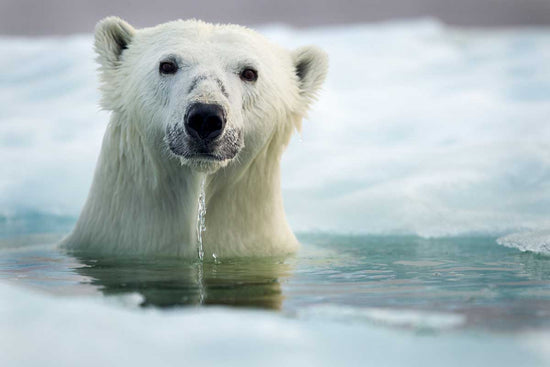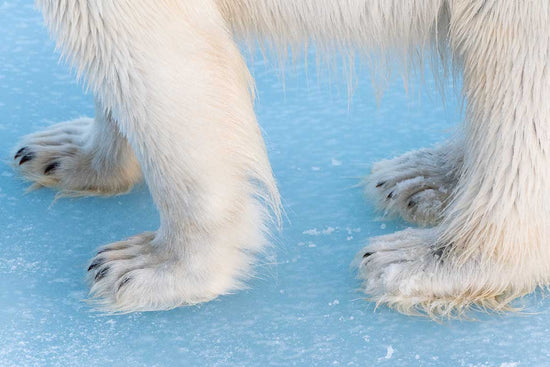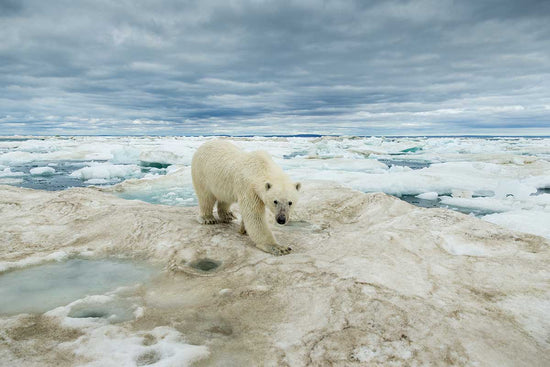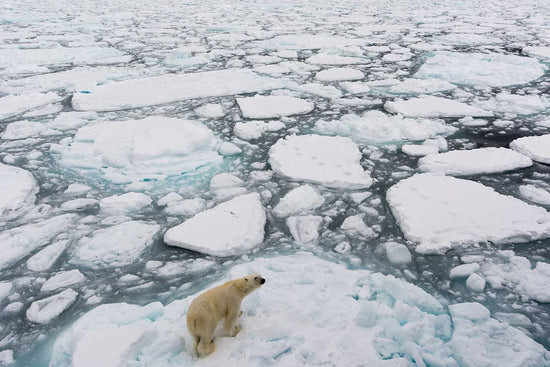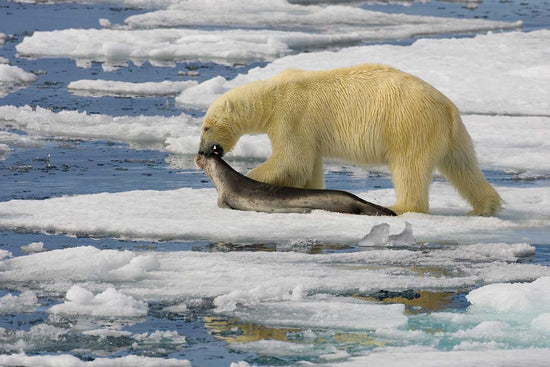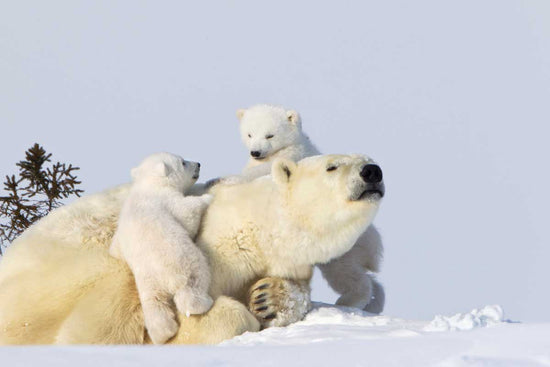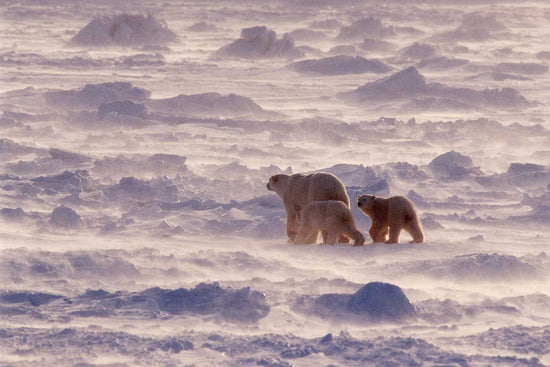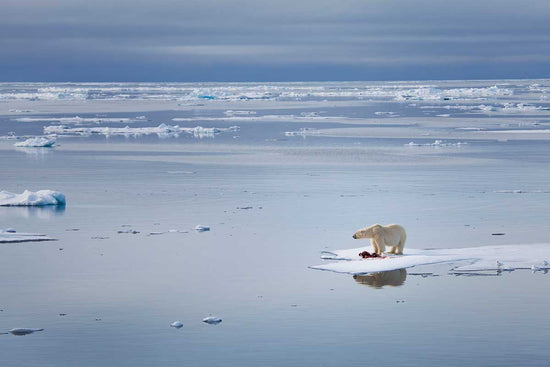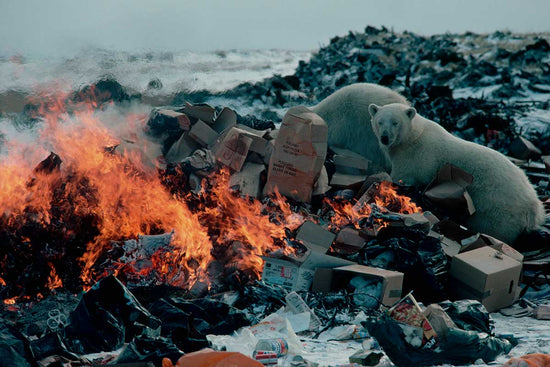All About Polar Bears, Our Cause of the Month for January 2023
Polar bears are struggling to cope with the impacts of climate change which is fueled, in part, by plastics
Polar bears are the largest bears and biggest land-based carnivores in the world. Thankfully, they’re mostly found in the Arctic Circle—one of our planet’s coldest environments—though some populations live in places like Alaska, Canada, Russia, and Greenland.
Descended from brown bears, polar bears are natural travelers who have developed all kinds of fascinating adaptations to survive in the winter wonderland they call home.
Just look at their paws for starters!
These babies are absolutely massive—about a foot wide—which helps them distribute their weight evenly as they walk across the frozen tundra. When they swim, their front paws act as paddles while their back paws act as rudders.
Their paws are covered in fur, even on the bottom, and have little bumps called papillae that provide traction and warmth on cold, slippery surfaces. Each toe ends in a fearsome claw that measures about two inches long; perfect for gripping the ice—and their prey.
Polar bears also have a thick layer of fat, small round ears, and short, compact tails. In addition to being adorable, these adaptations help prevent heat loss and allow our favorite sea bears to conserve the most warmth possible.
Famous for their stark white coats that help them camouflage with the ice and snow, most people are surprised to learn that polar bears aren’t actually white!
Instead, they have black skin and two coats of translucent, colorless fur. Each hair has a hollow core that scatters and reflects sunlight, which is what makes them appear white.
But if you ever see a polar bear with green fur, don’t worry! That sea bear isn’t sick; she’s just got a little algae growing in those long, hollow hairs of hers.
For polar bears, home is where the Arctic sea ice is.
Unlike icebergs, glaciers, and ice shelves that form on land before floating in the ocean, sea ice is frozen ocean water that forms, grows, and melts entirely in the ocean.
In fact, their entire existence—and their future—is completely dependent on this frozen ocean ecosystem. It’s where they mate and raise their cubs. It’s also how they access their primary food source, ringed seals, which are so rich in fat that they provide several days’ worth of food and energy.
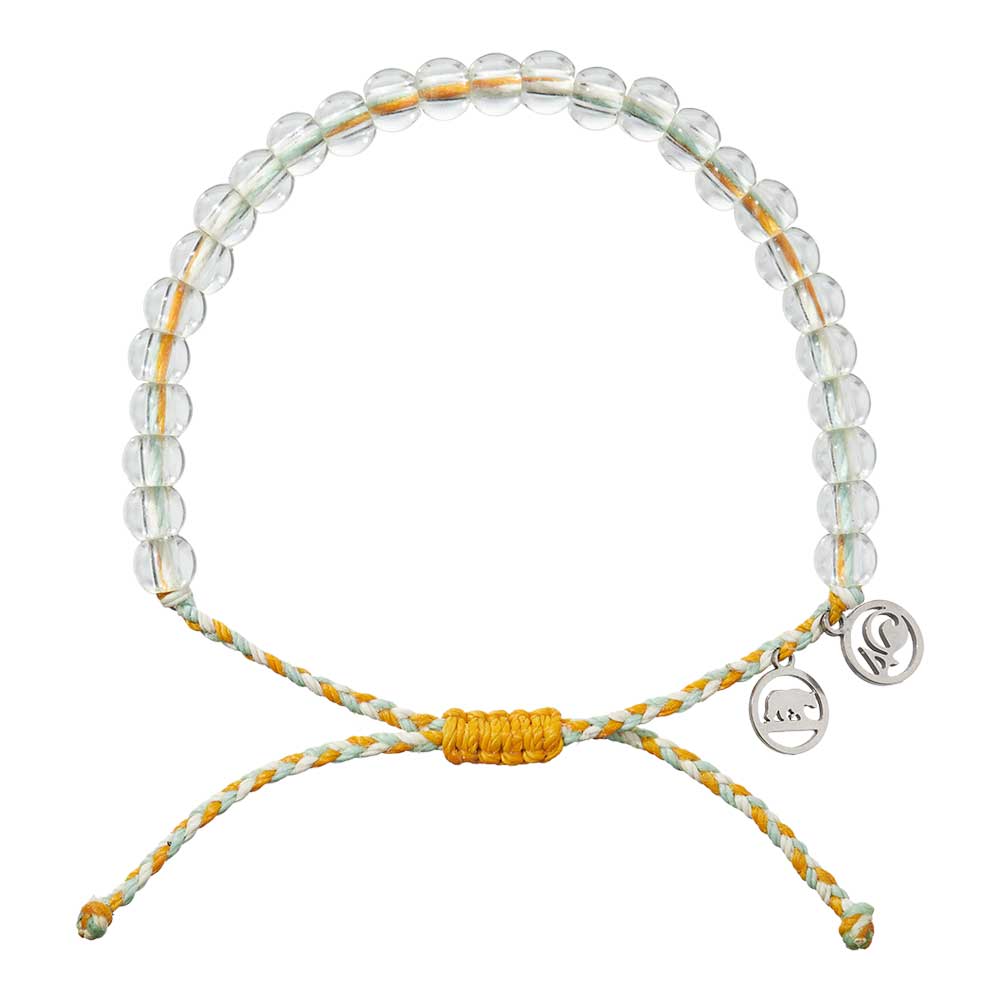
Polar Bear Bracelet of the Month — Limited Edition
By purchasing this bracelet, you will pull one pound of trash from the world’s oceans, rivers, and coastlines. Only available January 2023.
Sea ice is a vast and ever-changing habitat that expands and contracts with the seasons. Sea ice reaches its maximum extent in March and its lowest extent in September, which has a direct impact on polar bears’ habits and behaviors.
Mating season occurs between April and late June; though polar bears experience something called delayed implantation, which means fertilized eggs will not implant in the uterus until fall. And they’ll only do so if momma bear has stored up enough fat to sustain herself and her cubs through a long denning period; not enough nutrients means no polar bear cubs.
In summer and early fall, polar bears have one goal: prepare for winter by eating well and gaining as much weight as possible. Pregnant females will also use this time to prepare their den by digging a small cave in a snowdrift that’s just big enough for her to turn around in. Then, she’ll wait for snow to close the entrance and seal her inside.
In the wild, most polar bear cubs are born in December. A momma bear can give birth to anywhere from one to three cubs; twins are most common.
Born toothless, blind, and covered with soft white fur, newborn cubs are totally helpless and completely dependent on their momma.
During this time, momma bear is so devoted to nursing and caring for her cubs that she won’t leave the den, even to eat or drink. Instead, she relies on her summer fat stores to keep her alive.
Polar bears emerge from their dens between March and April when new cubs are strong enough to make the trek to sea ice where they’ll learn to hunt seals and survive in the Arctic.
But polar bears aren’t the only ones who rely on sea ice; humanity does too.
Just like our heart circulates blood and regulates body temperature, our oceans regulate Earth’s climate by circulating heat, moisture, and nutrients around the planet.
Sea ice acts like our air conditioning system, reflecting sunlight and heat back into space, which keeps our planet cool and habitable.
Because polar bears are at the top of the Arctic food chain, they are directly impacted by changes in sea ice quality and coverage. This makes them an important indicator species, which means scientists and researchers study polar bears to gain insight into the health of the Arctic ecosystem—and our planet as a whole.
And what we’ve learned from polar bears is that the Arctic is warming—and fast.
While the greenhouse effect is a natural process that warms the Earth’s surface and makes our planet habitable, human activities like burning fossil fuels, agriculture, and land clearing increase the amount of greenhouse gases released into the atmosphere.
These heat-trapping gases supercharge the natural greenhouse gas effect, trapping so much heat that Earth’s temperature rises, much like your body heat when you’re under a blanket for a long time.
A new study found that climate change has caused the Arctic to warm nearly four times faster than the rest of the world in less than 50 years.
Now, sea ice is melting out earlier in the summer and freezing up later in the fall, which means:
- Reduced access to prey
- Declines in body condition
- Lower cub survival rates
- Drowning
- Cannibalism
- Loss of access to denning areas
- Declining population size
From cradle to grave, at literally every stage of their lifecycle, plastics emit greenhouse gases that contribute to climate change and the disappearance of Arctic sea ice. In fact, plastics have become one of the world’s most significant and rapidly growing sources of industrial greenhouse gas emissions.
Without intervention to slow or stop climate change, sea ice habitats will cease to exist—and polar bears will disappear.
The good news is that polar bears are finding ways to adapt to our changing climate like hunting from freshwater ice glaciers when they can’t find sea ice.
But not all adaptations are equal.
Polar bears are powerful predators that don’t really fear humans. Without sea ice and seals, polar bears must search for other sources of food. On land, with their powerful sense of smell, they’re likely to venture into garbage dumps, food stores, and sled dog yards that offer easy pickings.
Naturally, this creates conflict with humans who rely on these resources. As polar bears become more desperate for food, they may begin to take even greater risks.
Ultimately, the greatest concern is that our climate is changing too quickly for polar bears to keep up. No matter what adaptations and strategies they develop to overcome the loss of their sea ice habitat, hundreds of thousands of years of evolution can’t be undone in 50 years.
We know that addressing climate change can feel overwhelming, but time and again, we’ve seen humanity come together to solve “impossible” challenges.
If you’re looking for a little hope, or maybe proof, just think about the last time you heard about the hole in the ozone layer. It’s probably been a while, right?
That’s because we passed a massive international agreement called the Montreal Protocol—the first treaty to achieve universal ratification by all countries in the world—which successfully phased out 99% of ozone-depleting substances. Scientists now estimate that the hole in the ozone layer will be healed by the 2060s.
And, together, we can do the same thing to end the interconnected threats of plastics and climate change.
So stay educated, stay involved, stay hopeful, and help us raise awareness about the importance of protecting polar bears and their sea ice habitats with our limited edition Polar Bear Bracelet of the Month!

Polar Bear Bracelet of the Month — Limited Edition
By purchasing this bracelet, you will pull one pound of trash from the world’s oceans, rivers, and coastlines. Only available January 2023.

